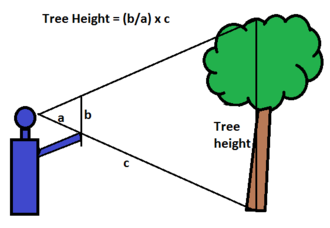Tree measurement
Tree measurement is a fundamental aspect of forestry, arboriculture, and environmental science that involves quantifying various dimensions of trees. These measurements are crucial for managing forest resources, assessing tree health and growth, and conducting ecological research. This article provides an overview of the key methods and metrics used in tree measurement.
Types of Tree Measurements
Height
The height of a tree is one of the most basic yet essential measurements. It can be measured using simple tools like a clinometer or more advanced methods such as Lidar technology. Height measurements are critical for calculating the volume of a tree, which is important for timber valuation and carbon sequestration studies.
Diameter at Breast Height (DBH)
Diameter at Breast Height (DBH) is a standard method of measuring a tree's diameter. It is taken at 1.3 meters (4.5 feet) above the ground. DBH is used to estimate the age and volume of a tree and is a critical parameter in forest inventory and management practices.
Crown Size
The crown of a tree consists of its leaves and branches. Measuring the crown size, including its width and area, provides insights into the tree's health, productivity, and the habitat it provides for wildlife. Techniques for measuring crown size vary from visual estimates to more precise measurements using photographic or laser scanning methods.
Volume
Volume measurement is vital for determining the amount of wood a tree contains, which is essential for timber production and carbon storage calculations. Various formulas and models exist to estimate tree volume based on height, DBH, and other tree dimensions.
Age
Determining the age of a tree can be done by counting the growth rings in a core sample taken with an increment borer. However, this method is invasive. Non-invasive methods include using growth models that estimate age based on tree size and species-specific growth rates.
Importance of Tree Measurement
Tree measurements are crucial for various applications, including:
- Forest management and conservation
- Timber and biomass production
- Urban planning and green space management
- Wildlife habitat assessment
- Climate change research through carbon stock and sequestration analysis
Challenges in Tree Measurement
Accurate tree measurement can be challenging due to factors such as tree shape, accessibility, and measurement technique limitations. Advances in technology, such as remote sensing and improved field equipment, are helping to overcome some of these challenges.
Conclusion
Tree measurement is a critical field of study that supports forest management, conservation efforts, and our understanding of the natural world. By accurately measuring trees, we can better manage forest resources, conserve biodiversity, and mitigate the effects of climate change.
| This article is a stub. You can help WikiMD by registering to expand it. |
Transform your life with W8MD's budget GLP-1 injections from $125.
W8MD offers a medical weight loss program to lose weight in Philadelphia. Our physician-supervised medical weight loss provides:
- Most insurances accepted or discounted self-pay rates. We will obtain insurance prior authorizations if needed.
- Generic GLP1 weight loss injections from $125 for the starting dose.
- Also offer prescription weight loss medications including Phentermine, Qsymia, Diethylpropion, Contrave etc.
NYC weight loss doctor appointments
Start your NYC weight loss journey today at our NYC medical weight loss and Philadelphia medical weight loss clinics.
- Call 718-946-5500 to lose weight in NYC or for medical weight loss in Philadelphia 215-676-2334.
- Tags:NYC medical weight loss, Philadelphia lose weight Zepbound NYC, Budget GLP1 weight loss injections, Wegovy Philadelphia, Wegovy NYC, Philadelphia medical weight loss, Brookly weight loss and Wegovy NYC
|
WikiMD's Wellness Encyclopedia |
| Let Food Be Thy Medicine Medicine Thy Food - Hippocrates |
Medical Disclaimer: WikiMD is not a substitute for professional medical advice. The information on WikiMD is provided as an information resource only, may be incorrect, outdated or misleading, and is not to be used or relied on for any diagnostic or treatment purposes. Please consult your health care provider before making any healthcare decisions or for guidance about a specific medical condition. WikiMD expressly disclaims responsibility, and shall have no liability, for any damages, loss, injury, or liability whatsoever suffered as a result of your reliance on the information contained in this site. By visiting this site you agree to the foregoing terms and conditions, which may from time to time be changed or supplemented by WikiMD. If you do not agree to the foregoing terms and conditions, you should not enter or use this site. See full disclaimer.
Credits:Most images are courtesy of Wikimedia commons, and templates, categories Wikipedia, licensed under CC BY SA or similar.
Contributors: Prab R. Tumpati, MD





